Daewoo Solar 55-V Shop Manual
Solar 55-V Plus
Shop Manual
023-00045AE
Serial Number 1001 and Up
TABLE OF CONTENTS |
|
Publication Request for Proposed Revision |
|
Safety |
|
Track Excavator Safety....................................................................... |
S0102035K |
Specifications |
|
Specifications for Solar 55-V PLUS .................................................... |
S0202035K |
General Maintenance |
|
General Maintenance Procedures ......................................................... |
S0302000 |
Standard Torques .................................................................................. |
S0309000 |
Upper Structure |
|
Lower Structure and Chassis |
|
Track Assembly ..................................................................................... |
S0505070 |
Engine and Drive Train |
|
Air Conditioner ....................................................................................... |
S0605015 |
Hydraulics |
|
Accumulator........................................................................................ |
S0703010K |
Center Joint (Swivel).............................................................................. |
S0704050 |
Cylinders................................................................................................ |
S0705000 |
Travel Motor..................................................................................... |
S0707370 R1 |
Swing Motor........................................................................................... |
S0707380 |
Main Pump............................................................................................. |
S0708370 |
Main Control Valve ............................................................................. |
S0709465K |
Pilot Control Valve (Work Lever / Joystick)............................................ |
S0709470 |
Hydraulic Schematic (Solar 55-V PLUS) ............................................ |
S0792095K |
Table of Contents
Page I
Electrical System
Electrical System ................................................................................ |
S0802085K |
Electrical Schematic (Solar 55-V PLUS)............................................. |
S0892095K |
Attachments
Bucket.................................................................................................... |
S0904000 |
Table of Contents
Page II
SAFETY

S0102035K
TRACK EXCAVATOR
SAFETY
 CAUTION!
CAUTION!
Follow all safety recommendations and safe shop practices outlined in the front of this manual or those contained within this section.
Always use tools and equipment that is in good working order.
Use lifting and hoisting equipment capable of safely handling load.
Remember, that ultimately safety is your own personal responsibility.
MODEL |
SERIAL NUMBER RANGE |
|
|
Solar 55-V PLUS |
1001 and Up |
|
|
Solar 75-V PLUS |
1001 and Up |
|
|
|
|
|
|
Track Excavator Safety |
S0102035K |
|
Page 1 |
TABLE OF CONTENTS |
|
To the Operator of a Daewoo Excavator ........................................................ |
5 |
Learn the Signal Words Used with the Safety Alert Symbol ................... |
7 |
General Safety Essentials .............................................................................. |
8 |
Accessory Applications ........................................................................... |
8 |
Lifting Capacity Rating Configuration...................................................... |
8 |
Location of Safety Labels ............................................................................... |
8 |
Summary of Safety Precautions for Lifting in Digging Mode .......................... |
9 |
Unauthorized Modifications .......................................................................... |
10 |
General Hazard Information ......................................................................... |
10 |
Safety Rules.......................................................................................... |
10 |
Safety Features ..................................................................................... |
10 |
Inside Operator's Compartment ............................................................ |
11 |
Clothing and Personal Protective Items ................................................ |
11 |
Breathing Masks, Ear Protection May Be Required .............................. |
12 |
Vibration Level Information.................................................................... |
12 |
Mounting and Dismounting ................................................................... |
13 |
Fuel, Oil and Hydraulic Fluid Fire Hazards ........................................... |
14 |
Precautions When Handling Fluids at High Temperature ..................... |
14 |
Asbestos Dust Hazard Prevention ........................................................ |
15 |
Injury from Work Equipment ................................................................. |
15 |
Fire Extinguisher and First Aid Kit......................................................... |
16 |
Protection from Falling or Flying Objects .............................................. |
16 |
Attachment Precautions ........................................................................ |
17 |
Accumulator .......................................................................................... |
17 |
Indoor Ventilation .................................................................................. |
18 |
Emergency Exit ..................................................................................... |
18 |
Before Starting Engine ................................................................................. |
19 |
Work Site Precautions........................................................................... |
19 |
Checks Before Starting Engine ............................................................. |
20 |
Engine Starting ..................................................................................... |
21 |
S0102035K |
Track Excavator Safety |
Page 2 |
|
Before Operating Machine .................................................................... |
21 |
Machine Operation ....................................................................................... |
22 |
When Swinging or Changing Direction of Travel ................................... |
22 |
Travel Precautions................................................................................. |
23 |
Traveling on Slopes ............................................................................... |
24 |
Prohibited Operations ........................................................................... |
24 |
Precautions for Operation ..................................................................... |
25 |
Avoid High-voltage Cables .................................................................... |
26 |
Operate Carefully on Snow, Ice and in Very Cold Temperatures .......... |
26 |
Operations on Slopes............................................................................ |
27 |
Parking Machine ................................................................................... |
27 |
Never Let Anyone Ride on Attachment ................................................. |
27 |
Maintenance................................................................................................. |
28 |
Warning Tag .......................................................................................... |
28 |
Clean Before Inspection or Maintenance .............................................. |
28 |
Proper Tools .......................................................................................... |
29 |
Use of Lighting ...................................................................................... |
29 |
Fire Prevention and Explosion Prevention ............................................ |
29 |
Burn Prevention .................................................................................... |
30 |
Welding Repairs.................................................................................... |
31 |
Warning for Counterweight and Front Attachment Removal ................. |
31 |
Precautions for Removal, Installation, and Storage of Attachments ..... |
32 |
Precautions when Working on Machine................................................ |
32 |
Lock Inspection Covers ......................................................................... |
32 |
Crushing Prevention and Cutting Prevention ........................................ |
33 |
Track Tension Adjustments Require Caution......................................... |
33 |
Supports and Blocking for Work Equipment ......................................... |
33 |
Action When Abnormally Is Found During Inspection........................... |
34 |
Precautions with High-pressure Line, Tubes and Hoses....................... |
34 |
Waste Materials .................................................................................... |
35 |
Battery.......................................................................................................... |
36 |
Battery Hazard Prevention .................................................................... |
36 |
Starting Engine With a Booster Cable .................................................. |
37 |
Track Excavator Safety |
S0102035K |
|
Page 3 |
Connecting the Booster Battery..................................................... |
38 |
Disconnecting the Booster Battery ................................................ |
38 |
Towing .......................................................................................................... |
39 |
Precautions When Towing..................................................................... |
39 |
Shipping and Transportation ........................................................................ |
40 |
Obey State and Local Over-the-Road Regulations............................... |
40 |
Lifting With Sling........................................................................................... |
40 |
S0102035K |
Track Excavator Safety |
Page 4 |
|

TO THE OPERATOR OF A DAEWOO EXCAVATOR
 DANGER!
DANGER!
Unsafe use of the excavator could lead to serious injury or death. Operating procedures, maintenance and equipment practices or traveling or shipping methods that do not follow the safety guidelines on the following pages could cause serious, potentially fatal injuries or extensive damage to the machine or nearby property.
Please respect the importance of taking responsibility for your own safety, and that of other people who may be affected by your actions.
The safety information on the following pages is organized into the following sections:
1.“General Safety Essentials” on page 8
2.“Location of Safety Labels” on page 8
3.“Summary of Safety Precautions for Lifting in Digging Mode” on page 9
4.“Unauthorized Modifications” on page 10
5.“General Hazard Information” on page 10
6.“Before Starting Engine” on page 19
7.“Machine Operation” on page 22
8.“Maintenance” on page 28
9.“Battery” on page 36
10.“Towing” on page 39
11.“Shipping and Transportation” on page 40
12.“Lifting With Sling” on page 40
Track Excavator Safety |
S0102035K |
|
Page 5 |

 WARNING!
WARNING!
Improper operation and maintenance of this machine can be hazardous and could result in serious injury or death.
Operator and maintenance personnel should read this manual thoroughly before beginning operation or maintenance.
Keep this manual in the storage compartment to the rear of the operator's seat, and have all personnel involved in working on the machine read the manual periodically.
Some actions involved in operation and maintenance of the machine can cause a serious accident, if they are not done in a manner described in this manual.
The procedures and precautions given in this manual apply only to intended uses of the machine.
If you use your machine for any unintended uses that are not specifically prohibited, you must be sure that it is safe for any others. In no event should you or others engage in prohibited uses or actions as described in this manual.
Daewoo delivers machines that comply with all applicable regulations and standards of the country to which it has been shipped. If this machine has been purchased in another country or purchased from someone in another country, it may lack certain safety devices and specifications that are necessary for use in your country. If there is any question about whether your product complies with the applicable standards and regulations of your country, consult Daewoo or your Daewoo distributor before operating the machine.
S0102035K |
Track Excavator Safety |
Page 6 |
|

 SAFETY ALERT SYMBOL
SAFETY ALERT SYMBOL 
Be Prepared - Get To Know All Operating and Safety Instructions.
This is the Safety Alert Symbol. Wherever it appears in this manual or on safety signs on the machine you should be alert to the potential for personal injury or accidents. Always observe safety precautions and follow recommended procedures.
LEARN THE SIGNAL WORDS USED WITH THE SAFETY ALERT SYMBOL
The words "CAUTION," "WARNING" and "DANGER" used throughout this manual and on decals on the machine indicate degree of risk of hazards or unsafe practices. All three degrees of risk indicate that safety is involved. Observe precautions indicated whenever you see the Safety Alert "Triangle," no matter which signal word appears next to the "Exclamation Point" symbol.
 CAUTION!
CAUTION!
Indicates potential of a hazardous situation that, if not avoided, could result in minor or moderate injury. It may also be used to alert against a generally unsafe practice.
 WARNING!
WARNING!
Indicates potential of a hazardous situation that, if not avoided, could result in serious injury or death. It may also be used to alert against a highly unsafe practice.
 DANGER!
DANGER!
Indicates imminent hazard of a situation that, if not avoided, is very likely to cause death or extremely serious injury. It may also be used to alert against equipment that may explode or detonate if handled or treated carelessly.
Safety precautions are described in SAFETY from page -8 on.
Daewoo cannot predict every circumstance that might involve a potential hazard in operation and maintenance. Therefore the safety messages in this manual and on the machine may not include all possible safety precautions. If any procedures or actions not specifically recommended or allowed in this manual are used, you must be sure that you and others can do such procedures and actions safely and without damaging the machine. If you are unsure about the safety of some procedures, contact a DAEWOO distributor.
Track Excavator Safety |
S0102035K |
|
Page 7 |

GENERAL SAFETY ESSENTIALS
ACCESSORY APPLICATIONS
The excavator has been primarily designed for moving earth with a bucket. For use as a grapple or for other object handling, contact Daewoo for proper installation and application. Lifting-work applications (unless restricted or prohibited by local regulations) are permitted in approved lift configuration, to rated capacity only, with no side-loading. Do not use the machine for activities for which it was not intended. Do not use the bucket for lifting work, unless lift slings are used in the approved configuration.
Use of an accessory hydraulic hammer (breaker), work in rough terrain, demolition applications or other hazardous operation may require installation of additional protective structures to safeguard the operator.
LIFTING CAPACITY RATING CONFIGURATION
Lifting capacity ratings that are printed at the end of this safety section are based on the machine being level, on a firm supporting surface, with hooks and slings attached in approved configuration. Loads must be balanced and supported evenly. Use taglines to keep the load steady if wind conditions and large surface area are a problem. Work crew hand signals, individual tasks and safe procedures should all be universally understood before the lift is made.
IMPORTANT
Before using the excavator to make lifts check municipal and regional regulations or statutes that could apply. Governing ordinances may require that all heavy lifting be done with single purpose equipment specifically designed for making lifts, or other local restrictions may apply. Making heavy lifts with a general purpose excavator that can be used for digging, loading, grading or other work may be expressly forbidden by a regional injunction or other legal prohibition. Always follow all of the other instructions, guidelines and restrictions for Safe Lifting in the Operation and Maintenance Manuals.
LOCATION OF SAFETY LABELS
Location of safety labels (decals) can vary from unit to unit. Refer to appropriate Operation and Maintenance Manual, and parts manual for your unit.
Always replace damaged or faded decals.
S0102035K |
Track Excavator Safety |
Page 8 |
|

SUMMARY OF SAFETY PRECAUTIONS FOR LIFTING IN DIGGING MODE
 DANGER!
DANGER!
Unsafe use of the excavator while making rated lifts could cause serious, potentially fatal injuries or extensive damage to the machine or nearby property. Do not let anyone operate the machine unless they've been properly trained and understand the information in the Operation and Maintenance Manual.
To lift safely while in Digging Mode, the following items must be evaluated by the operator and the work site crew.
•Condition of ground support.
•Excavator configuration and attachments.
•Weight, lifting height and lifting radius.
•Safe rigging of the load.
•Proper handling of the suspended load.
Taglines on opposite sides of the load can be very helpful in keeping a suspended load secure, if they are anchored safely to control points on the ground.
 WARNING!
WARNING!
NEVER wrap a tagline around your hands or body.
NEVER rely on taglines or make rated lifts when wind gusts are more than 48.3 km/h (30 MPH). Be prepared for any type of wind gust when working with loads that have a large surface area.
Always engage the "Digging Mode" control on the Instrument Panel before using the excavator for lifting work.
 WARNING!
WARNING!
If you need more information or have any questions or concerns about safe operating procedures or working the excavator correctly in a particular application or in the specific conditions of your individual operating environment, please consult your local Daewoo representative.
Track Excavator Safety |
S0102035K |
|
Page 9 |
UNAUTHORIZED MODIFICATIONS
Any modification made without authorization or written approval from Daewoo can create a safety hazard, for which the machine owner must be held responsible.
For safety's sake, replace all OEM parts with the correct authorized or genuine Daewoo part. For example, not taking the time to replace fasteners, bolts or nuts with the correct replacement parts could lead to a condition in which the safety of critical assemblies is dangerously compromised.
GENERAL HAZARD INFORMATION
SAFETY RULES
Only trained and authorized personnel can operate and maintain the machine.
Follow all safety rules, precautions and instructions when operating or performing maintenance on the machine.
Do not operate the machine if you are not feeling well, if you are taking medication that makes you feel sleepy, if you have been drinking, or if you are suffering from emotional problems. These problems will interfere with your sense of judgement in emergencies and may cause accidents.
When working with another operator or with a person on work site traffic duty, be sure that all personnel know the nature of the work and understand all hand signals that are to be used.
Always observe strictly any other rules related to safety.
SAFETY FEATURES
Be sure that all guards and covers are installed in their proper position. Have guards and covers repaired immediately if damaged.
Be sure that you understand the method of use of safety features such as safety lock lever and the seat belt, and use them properly.
Never remove any safety features. Always keep them in good operating condition.
Failure to use safety features according to the instructions in the Operation and Maintenance Manual could result in serious bodily injury.
S0102035K |
Track Excavator Safety |
Page 10 |
|
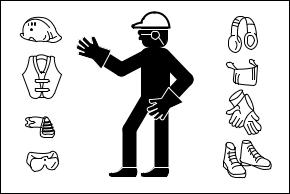
INSIDE OPERATOR'S COMPARTMENT
When entering the operator's compartment, always remove all mud and oil from the soles of your shoes. If you operate the travel pedal with mud or oil stuck to your shoes, your foot may slip and this may cause a serious accident.
After using the ashtray, make sure that any matches or cigarettes are properly extinguished, and be sure to close the ashtray. If the ashtray is left open, there is danger of fire.
Do not stick suction pads to the window glass. Suction pads act as a lens and may cause fire.
Do not leave lighters laying around the operator's compartment. If the temperature inside the operator's compartment becomes high, there is danger that the lighter may explode.
Do not use cellular telephones inside the operator's compartment when driving or operating the machine. There is danger that this may lead to an unexpected accident.
Never bring any dangerous objects such as flammable or explosive items into the operator's cab.
To ensure safety, do not use the radio or music headphones when operating the machine. There is danger that this may lead to a serious accident.
When operating the machine, do not put your hands or head out of the window.
When standing up from the operator's seat, always place safety lock lever securely in the "LOCK" position. If you accidentally touch the work equipment levers when they are not locked, the machine may suddenly move and cause serous injury or damage.
When leaving the machine, lower the work equipment completely to the ground, set safety lock lever to the "LOCK" position and shut down engine. Use the key to lock all the equipment. Always remove the key and take it with you.
CLOTHING AND PERSONAL PROTECTIVE
ITEMS
Contain long hair, and avoid loose clothing and jewelry. They can catch on controls or in protruding parts and cause serious injury or death.
Do not wear oily clothes. They are highly flammable.
Full eye protection, a hard hat, safety shoes and gloves may be required at the work site.
While working on the machine, never use
HAOA020L
inadequate tools. They could break or slip, causing injury, or they may not adequately perform intended functions.
Figure 1
Do not forget that some risks to your health may not be immediately apparent. Exhaust gases and noise pollution may not be visible, but these hazards can cause disabling or permanent injuries.
Track Excavator Safety |
S0102035K |
|
Page 11 |
BREATHING MASKS, EAR PROTECTION MAY BE REQUIRED
Do not forget that some risks to your health may not be immediately apparent. Exhaust gases and noise pollution may not be visible, but these hazards can cause disabling or permanent injuries.
NOTE: The equivalent continuous A-weighted sound pressure level at the workstation for this machine is given in the operation manual.
Measurement is obtained on a dynamic machine following the procedures and cab conditions as described in ISO 6396.
NOTE: The guaranteed sound power level emitted by the machinery for this machine is given in the operation manual.
Measurement is obtained on a dynamic machine with the procedures as described in 2000/14/EC.
VIBRATION LEVEL INFORMATION
Hands/Arms: The weighted root mean square acceleration to which the hands/arms are subjected, is less than 2.5 m/s2.
Whole body: The weighted root mean square acceleration to which the whole body is subjected, is less than 0.5 m/s2.
Measurements are obtained on a representative machine, using measuring procedures as set forth in the following standard: ISO 2631/1. ISO 5349, and SAE J1166.
S0102035K |
Track Excavator Safety |
Page 12 |
|

MOUNTING AND DISMOUNTING
Before getting on or off the machine, if there is any oil. grease, or mud on the handrails, steps, or track shoes, wipe it off immediately. Always keep these parts clean. Repair any damage and tighten any loose bolts.
Never jump on or off the machine. In particular, never get on or off a moving machine. These actions may lead to serious injury.
When getting on or off the machine, always face the machine, and maintain three-point contact (both feet and one hand or one foot and both hands) with the handrails, steps, and track shoes to ensure that you support yourself securely.
Never hold any control levers when getting on or off the machine.
Apply the door lock securely. If you grip the handrail inside the door when moving on top of the track shoes, and the door lock is not applied securely, the door may move and cause you to fall.
Use the points marked by arrows in the diagram when getting on or off the machine.
AXO0060L
Figure 2
Track Excavator Safety |
S0102035K |
|
Page 13 |
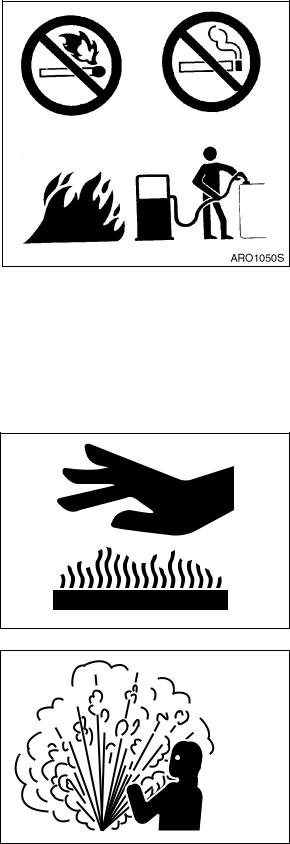
FUEL, OIL AND HYDRAULIC FLUID FIRE HAZARDS
Fuel, oil and antifreeze will catch fire if it is brought close to a flame. Fuel is particularly flammable and can be hazardous.
Always strictly observe the following.
Add fuel, oil, antifreeze and hydraulic fluid to the machine only in a well-ventilated area. The machine must be parked with controls, lights and switches turned "OFF." The engine must be "OFF" and any flames, glowing embers, auxiliary heating units or spark-causing equipment must be doused, turned off and/or kept well clear of the machine.
Static electricity can produce dangerous sparks at the fuel filling nozzle. In very cold, dry weather or other conditions that could produce a static discharge, keep the tip of the fuel nozzle in constant contact with the neck of the fuel filling nozzle, to provide a ground.
Keep fuel and other fluid reservoir caps tight and do not start the engine until caps have been secured.
PRECAUTIONS WHEN HANDLING FLUIDS AT HIGH TEMPERATURE
Immediately after operations are stopped, the coolant, engine oil, and hydraulic oil are at high temperature and the radiator and hydraulic tank are still under pressure. Attempting to remove the cap, drain the oil or coolant, or replace the filters may lead to serious burns. Always wait for the temperature to go down, and follow the specified procedures when carrying out these operations.
To prevent hot coolant from spurting out, shut down engine, wait for the coolant to cool, then loosen the cap slowly to relieve the pressure.
To prevent hot oil from spurting out, shut down engine, wait for the oil to cool, then loosen the cap slowly to relieve the pressure.
Figure 3
HAOA050L
Figure 4
HAOA060L
Figure 5
S0102035K |
Track Excavator Safety |
Page 14 |
|
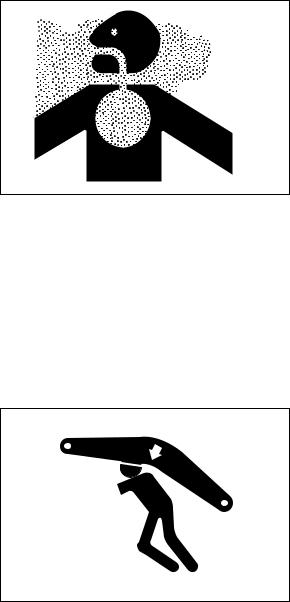
ASBESTOS DUST HAZARD PREVENTION
Asbestos dust can be HAZARDOUS to your health if it is inhaled. Materials containing asbestos fiber can be present on work site. Breathing air that contains asbestos fiber can ultimately cause serious or fatal lung damage. To prevent lung damage from asbestos fiber, observe following precautions;
•Use a respirator that is approved for use in an asbestos-laden atmosphere.
•Never use compressed air for cleaning.
•Use water for cleaning to keep down the dust.
•Work on the machine or component with the wind at your back whenever possible.
•Always observe any rules and regulations related to the work site and working environment.
INJURY FROM WORK EQUIPMENT
Do not enter or put your hand, arm or any other part of your body between movable parts, such as between the work equipment and cylinders, or between the machine and work equipment.
If the control levers are operated, the clearance between the machine and the work equipment will change and this may lead to serious damage or personal injury.
If going between movable parts is necessary, always position and secure the work equipment so that it cannot move.
ARO1770L
Figure 6
HDO1010L
Figure 7
Track Excavator Safety |
S0102035K |
|
Page 15 |
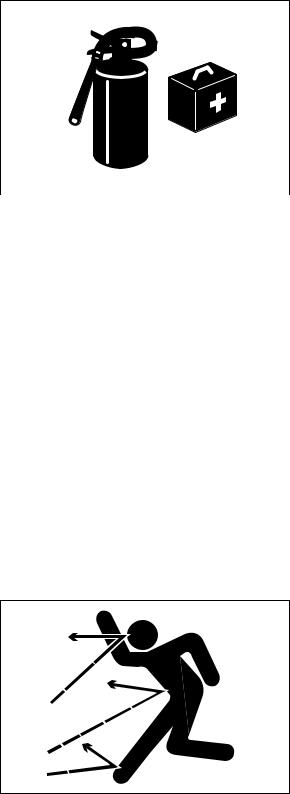
FIRE EXTINGUISHER AND FIRST AID KIT
As a precaution if any injury or fire should occur, always do the following.
• |
Be sure that fire extinguishers have |
|
|||
|
been provided and read the labels to |
|
|||
|
ensure that you know now to use |
|
|||
|
them. It is recommended that an |
|
|||
|
appropriately sized (2.27 kg [5 lb] or |
|
|||
|
larger) |
multipurpose |
"A/B/C" |
fire |
|
|
extinguisher be mounted in the cab. |
|
|||
|
Check |
and service |
the |
fire |
HDO1009L |
|
extinguisher at regular intervals and |
||||
|
|
||||
|
Figure 8 |
||||
|
make sure that all work site crew |
||||
|
|
||||
|
members are adequately trained in |
|
|||
|
its use. |
|
|
|
|
•Provide a first aid kit in the storage compartment and keep another at the work site. Check the kit periodically and make any additions if necessary.
•Know what to do in case of injury from fire.
•Keep emergency numbers for doctor, ambulance service, hospital and fire department near your telephone.
If the machine catches fire, it may lead to serious personal injury or death. If a fire occurs during operation, escape from the machine as follows;
•Turn the starter switch "OFF" and shut down engine.
•If there is time, use the fire extinguisher to extinguish as much of the fire as possible.
•Use the handrails and steps to escape from the machine.
The above is the basic method for escaping from the machine, but changing the method may be necessary according to the conditions, so carry out practice drills at the work site.
PROTECTION FROM FALLING OR FLYING OBJECTS
On work sites where there is danger that falling objects or flying objects may hit the operator's cab select a guard to match the operating conditions to protect the operator.
Working in mines, tunnels, deep pits or on loose or wet surfaces could produce danger of falling rock or hazardous flying objects. Additional protection for the operator's cab could be required in the form of a FOPS (Falling Object Protective Structure) or window guards.
HAOA110L
Figure 9
S0102035K |
Track Excavator Safety |
Page 16 |
|
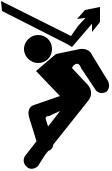
Never attempt to alter or modify any type of |
|
||||||
|
|||||||
protective structure reinforcement system, by |
|
||||||
drilling holes, welding, remounting or relocating |
|
||||||
fasteners. Any serious impact or damage to the |
|
||||||
system |
requires |
a |
complete |
integrity |
|
||
reevaluation. Reinstallation, recertification and/ |
|
||||||
or replacement of the system may be |
|
||||||
necessary. |
|
|
|
|
|
||
Contact your Daewoo distributor for available |
|
||||||
safety guards and/or recommendations if there |
|
||||||
is any danger of getting hit by objects that could |
|
||||||
strike |
the |
|
operator's |
cab. Make sure that all |
HAOA100L |
||
other |
work |
site crew |
members are |
kept well |
Figure 10 |
||
away from the excavator and safe from possible hazards.
For breaker operation, install a front guard and apply a laminated coating sheet to the front glass. Contact your DAEWOO distributor for recommendations.
When carrying out demolition or cutting operation, install a front guard and top guard, and apply a laminated coating sheet to the front glass.
When working in mines or quarries where there is danger of falling rock, install FOPS (Falling Objects Protective Structure) and apply a laminated coating sheet to the front glass.
If any glass on the machine is broken, replace it with new glass immediately.
ATTACHMENT PRECAUTIONS
Option kits are available through your dealer. Contact Daewoo for information on available one-way (single-acting) and two-way (double-acting) piping / valving / auxiliary control kits. Because Daewoo cannot anticipate, identify or test all of the attachments that owners may wish to install on their machines, please contact Daewoo for authorization and approval of attachments, and their compatibility with options kits.
ACCUMULATOR
The pilot control system is equipped with an accumulator. For a brief period of time after the engine has been shut down, the accumulator will store a pressure charge that may enable hydraulic controls to be activated. Activation of any controls may enable the selected function to operate under force of gravity.
When performing maintenance on the pilot control system, the hydraulic pressure in the system must be released as describe in "Handling of Accumulator" in the Operation and Maintenance Manual.
The accumulator is charged with high-pressure nitrogen gas, so it is extremely dangerous if it is handled in the wrong way. Always observe the following precautions;
•Do not drill or make any holes in the accumulator or expose it any flame, fire or heat source.
•Do not weld on the accumulator, or try attaching anything to it.
•When carrying out disassembly or maintenance of the accumulator, or when disposing of the accumulator, the charged gas must be properly released. Contact your Daewoo distributor.
•Wear safety goggles and protective gloves when working on an accumulator. Hydraulic oil under pressure can penetrate the skin and cause serious injuries.
Track Excavator Safety |
S0102035K |
|
Page 17 |
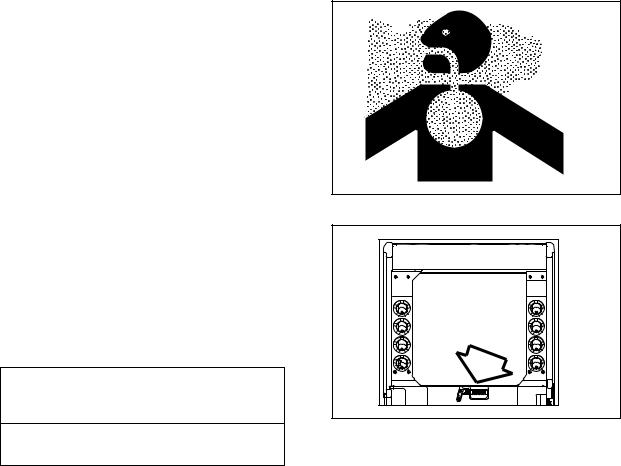
INDOOR VENTILATION
Engine exhaust gases can cause fatal accidents, and unconsciousness, loss of alertness, judgement and motor control and serious injury.
Make sure there is adequate ventilation before starting the engine in any enclosed area.
You should also be aware of open windows, doors or ductwork into which exhaust may be carried, or blown by the wind, exposing others to danger.
EMERGENCY EXIT
This machine is equipped with a glass breaking tool. It is behind the operator seat in the upper right corner of the cab. This tool can be used in case of an emergency situation that requires the breaking of glass to exit from the operator's cabin. Grip the handle firmly and use the sharp point to break the glass.
 WARNING!
WARNING!
Protect your eyes when breaking the glass.
ARO1770L
Figure 11
AXO0070L
Figure 12
S0102035K |
Track Excavator Safety |
Page 18 |
|
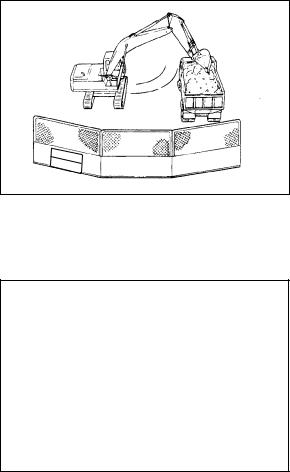
BEFORE STARTING ENGINE
WORK SITE PRECAUTIONS
Before starting operations, thoroughly check the area for any unusual conditions that could be dangerous.
Check the terrain and condition of the ground at the work site, and determine the best and safest method of operation.
Make the ground surface as hard and horizontal as possible before carrying out operations. If there is a lot of dust and sand on the work site, spray water before starting operations.
If you need to operate on a street, protect pedestrians and cars by designating a person for work site traffic duty or by erecting fences and posting "No Entry" signs around the work site.
Erect fences, post "No Entry" signs, and take other steps to prevent people from coming close to or entering the work site. If people come close to a moving machine, they may be hit or caught by the machine, and this may lead to serious personal injury or death.
Water lines, gas lines, phone lines and high-voltage electrical lines may be buried under the work site. Contact each utility and identify their locations. Be careful not to damage or cut any of these lines.
Check the condition of the river bed, and the depth and flow of the water before operating in water or crossing a river. NEVER be in water that is in excess of the permissible water depth.
Any type of object in the vicinity of the boom could represent a potential hazard, or cause the operator to react suddenly and cause an accident. Use a spotter or signal person working near bridges, phone lines, work site scaffolds, or other obstructions.
 DANGER
DANGER
No Entry
ARO1250L
Figure 13
Figure 14
Track Excavator Safety |
S0102035K |
|
Page 19 |
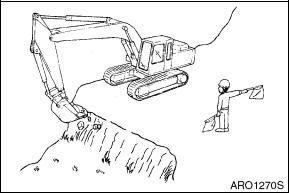
Minimum levels of insurance coverage, work permits or certification, physical barriers around the work site or restricted hours of operation may be mandated by governing authorities. There may also be regulations, guidelines, standards or restrictions on equipment that may have to be followed for local requirements. There may also be regulations related to performing certain kinds of work. If there is any question about whether your machine and work site complies with the applicable standards and regulations contact your local authorities and
agencies.
Figure 15
Avoid entering soft ground. It will be difficult for the machine to escape.
Avoid operating your machine to close to the edge of cliffs, overhangs, and deep ditches. The ground may be weak in such areas. If the ground should collapse, the machine could fall or tip over and this could result in serious injury or death.
Remember that the soil after heavy rain, blasting or after earthquakes, is weakened in these areas.
Earth laid on the ground and the soil near ditches is loose. It can collapse under the weight of vibration of your machine and cause your machine to tip over.
Install the head guard (FOPS) if working in areas where there is danger of falling rocks.
CHECKS BEFORE STARTING ENGINE
Every day before starting the engine for the first time, carry out the following checks. If these checks are not carried out properly, there is danger of serious injury.
Completely remove all wood chips, leaves, grass, paper and other flammable materials accumulated in the engine compartment and around the battery. They could cause a fire. Remove any dirt from the window glass, mirrors, handrails, and steps.
Do not leave tools or spare parts laying around in the operator's compartment. The vibration of the machine when traveling or during operations may cause them to fall and damage or break the control levers or switches. They may also get caught in the gap of the control levers and cause the work equipment to malfunction or move dangerously. This may lead to unexpected accidents.
Check the coolant level, fuel level, and hydraulic tank oil level, and check for clogged air cleaner and damage to the electrical wiring.
Adjust the operator's seat to a position where it is easy to operate the machine, and check the seat belt and mounts for damage and wear.
Check the operation of the gauges and the angle of the mirrors, and check that the safety lever is in "LOCKED" position.
If any abnormalities are found in the above checks, carry out repairs immediately.
S0102035K |
Track Excavator Safety |
Page 20 |
|
ENGINE STARTING
Walk around your machine before getting in the operator's cab. Look for evidence of leaking fluid, loose fasteners, misaligned assemblies or any other indications of possible equipment hazard.
All equipment covers and machinery safety guards must be in place, to protect against injury while the machine is being operated.
Look around the work site area for potential hazards, people or properly that could be at risk while operation is in progress.
NEVER start the engine if there is any indication that maintenance or service work is in progress, or if a warning tag is attached to controls in the cab.
A machine that has not been used recently, or is being operated in extremely cold temperatures, could require a warm-up or maintenance service before start-up.
Check gauges and monitor displays for normal operation before starting the engine. Listen for unusual noises and remain alert for other potentially hazardous conditions at the start of the work cycle.
Do not short circuit the starting motor to start the engine. This is not only dangerous, but may also damage the machine.
When starting the engine, sound the horn as an alert.
Start and operate the machine only while seated.
BEFORE OPERATING MACHINE
If checks are not carried out properly after starting the engine, it may result in a delay in discovering abnormalities in the machine, and this may lead to personal injury or damage to the machine.
Carry out the checks in an open area where there are no obstructions. Do not let anyone near the machine when carrying out the checks.
•Check the operating condition of the equipment, and the actuation of the bucket, arm, boom, travel, and swing systems.
•Check the machine for any abnormal noise, vibration, heat, smell, or abnormality with the gauges. Check also for leakage of air, oil, and fuel.
•If any abnormality is found, repair the problem immediately. If the machine is used without repairing the problems, it may lead to unexpected injury or failure.
•Clear all personnel from directly around machine and from the area.
•Clear all obstacles from the machine's path. Beware of hazards.
•Be sure that all windows are clean. Secure the doors and the windows in the open position or in the shut position.
•Adjust the rear view mirrors for best visibility close to the machine. Make sure that the horn, the travel alarm (if equipped), and all other warning devices are working properly.
•Fasten the seat belt securely.
•Warm up the engine and hydraulic oil before operating machine.
•Before moving the machine, check the position of undercarriage. The normal travel position is with idler wheels to the front under the cab and the drive sprockets to the rear. When the undercarriage is in the reversed position, the travel controls must be operated in opposite directions.
Track Excavator Safety |
S0102035K |
|
Page 21 |
